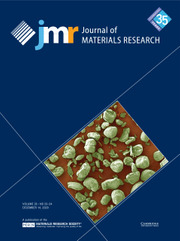Crossref Citations
This article has been cited by the following publications. This list is generated based on data provided by
Crossref.
Patzke, Greta Ricarda
and
Zhou, Ying
2007.
Targeted Synthesis of Nanostructured Oxide Materials.
MRS Proceedings,
Vol. 1056,
Issue. ,
Fei, Hai-Long
Shen, Zhu-Rui
Wang, Jin-Gui
Zhou, Hui-Jing
Ding, Da-Tong
and
Chen, Tie-Hong
2008.
Novel bi-cation intercalated vanadium bronze nano-structures for stable and high capacity cathode materials.
Electrochemistry Communications,
Vol. 10,
Issue. 10,
p.
1541.
Zhou, Ying
Pienack, Nicole
Bensch, Wolfgang
and
Patzke, Greta R.
2009.
The Interplay of Crystallization Kinetics and Morphology in Nanostructured W/Mo Oxide Formation: An in situ Diffraction Study.
Small,
Vol. 5,
Issue. 17,
p.
1978.
Tiano, Amanda L.
Koenigsmann, Christopher
Santulli, Alexander C.
and
Wong, Stanislaus S.
2010.
Solution-based synthetic strategies for one-dimensional metal-containing nanostructures.
Chemical Communications,
Vol. 46,
Issue. 43,
p.
8093.
Conrad, Franziska
Zhou, Ying
Yulikov, Maxim
Hametner, Kathrin
Weyeneth, Stephen
Jeschke, Gunnar
Günther, Detlef
Grunwaldt, Jan‐Dierk
and
Patzke, Greta R.
2010.
Microwave‐Hydrothermal Synthesis of Nanostructured Zinc‐Copper Gallates.
European Journal of Inorganic Chemistry,
Vol. 2010,
Issue. 13,
p.
2036.
Zhou, Ying
Vuille, Kathrin
Heel, Andre
Probst, Benjamin
Kontic, Roman
and
Patzke, Greta R.
2010.
An inorganic hydrothermal route to photocatalytically active bismuth vanadate.
Applied Catalysis A: General,
Vol. 375,
Issue. 1,
p.
140.
Avansi, Waldir
Ribeiro, Cauê
Leite, Edson R.
and
Mastelaro, Valmor R.
2011.
An efficient synthesis route of Na2V6O16·nH2O nanowires in hydrothermal conditions.
Materials Chemistry and Physics,
Vol. 127,
Issue. 1-2,
p.
56.
Patzke, Greta R.
Zhou, Ying
Kontic, Roman
and
Conrad, Franziska
2011.
Oxidische Nanomaterialien: Von der Synthese über den Mechanismus zur technologischen Innovation.
Angewandte Chemie,
Vol. 123,
Issue. 4,
p.
852.
Patzke, Greta R.
Zhou, Ying
Kontic, Roman
and
Conrad, Franziska
2011.
Oxide Nanomaterials: Synthetic Developments, Mechanistic Studies, and Technological Innovations.
Angewandte Chemie International Edition,
Vol. 50,
Issue. 4,
p.
826.
Li, Chunsheng
Sun, Yan
Ma, Xuegang
Hu, Yiwen
and
Wang, Yandi
2013.
Ultrathin α‐Mg
2
V
2
O
7
nanosheets: controllable fabrication and their formation mechanism
.
Micro & Nano Letters,
Vol. 8,
Issue. 11,
p.
846.
Li, Chunsheng
Sun, Yan
Ma, Xuegang
Yao, Weixue
Hu, Yiwen
Wang, Yandi
and
Wang, Yaozu
2014.
Ultralong triclinic-Ba2V2O7 nanowires: microwave radiation-assisted CTAB surfactant synthesis, the novel growth mechanism and optical activity performances.
RSC Advances,
Vol. 4,
Issue. 19,
p.
9737.
Sun, Yan
Wang, Jianli
Chen, Mingzhe
Li, Chunsheng
Hu, Zhenpeng
and
Chou, Shu-Lei
2017.
Screw dislocation-driven t-Ba2V2O7 helical meso/nanosquares: microwave irradiation assisted-SDBS fabrication and their unique magnetic properties.
Journal of Materials Chemistry C,
Vol. 5,
Issue. 25,
p.
6336.
Deng, Yonghui
2019.
Semiconducting Metal Oxides for Gas Sensing.
p.
53.
Deng, Yonghui
2023.
Semiconducting Metal Oxides for Gas Sensing.
p.
75.




